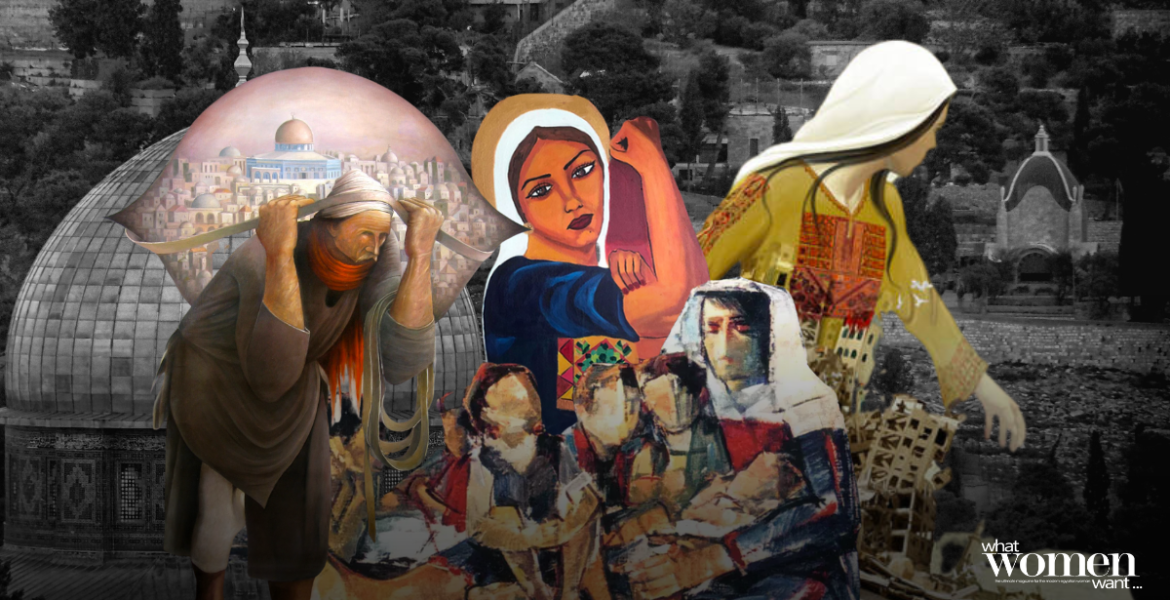Art is a vital tool to document historical events to preserve them for future generations, especially in cases of genocide. Also, it adds a human aspect and humanizes distant events. It can promote understanding and reconciliation between groups as it can transcend languages and be widely understood. Art instills hope and resistance in marginalized. Palestinians have picked brushes and paint to tell their stories and mark their place in history.
The Nakba

The Nakba, catastrophe in Arabic, refers to the mass displacement of three-quarters of Palestinians either by acts of intimidation or force of arms. Due to Hitler’s terror in Europe, many Jewish people escaped and sought refuge in Palestine. A UN committee proposed to divide Palestine into a Jewish and Arab state. They disregarded the thousand of Palestinians living there for generations. By the end of 1947, zionists had developed paramilitary forces, largest one known as the Hagana, which adopted Plan Doet, known as Plan D. Several brutal instructions called for the destruction of villages by setting fire to blowing up and planting mines. Plan D became the blueprint for carrying out the ethnic cleansing of historic Palestine to make room for a new state.
The Naksah

The Naksah, or day of decline, refers to the defeat of the combined army forces of Egypt, Syria, Iraq, and Jordan against the Israeli occupation army in 1967. It altered the landscape of Palestine once again. On the morning of June 5th, Israel launched a sneak attack on Egypt destroying its air force. The Israeli army forces directly dismissed the agreed upon Green Line borders drawn up in 1949 and took over the Egyptian Sinai Peninsula, Gaza Strip, West Bank, Old City of Jerusalem, and Golan Heights. The six-day war was a manifestation of Israel’s intent for territorial expansion and provoking a war. Around 400,000 Palestinians were displaced in addition to the mass displacement in the Nakba, so the number of refugees grew even further.
The First Intifada

The term intifada is the uprising of Palestinians in occupied territories with the mission of freeing Palestine and creating an independent state. The First Intifada began in December 1987 and ended in September 1993 due to the signing of the first Oslo Accords, which created a framework for peace negotiations. It began after an Israeli jeep ran over four Palestinian men in front of Jabalya refugee camps. They were a spontaneous series of Palestinian resistance, which included boycotting, demonstrations, and refusing to work in Israel. To end protests, the occupation’s army forces killed, wounded, and arrested thousands of Palestinians.
The Second Intifada

The second Intifada, commonly known as Al-Aqsa intifada, began in September 2000 and ended in late 2005. It was triggered by the Prime Minister Ariel Sharon’s visit to the Al-Aqsa Mosque to provoke Palestine. This intifada was met with more violence than the first, with over 3,000 Palestinians martyred. During this time, Israel began the construction of a wall to surround the West Bank. The wall was deemed illegal by the International Court of Justice (ICJ). The Second Intifada highlighted the failure of years of negotiations and marked a point in both Israeli and Palestinian politics.
Today

Today, we are currently witnessing horrific mass bombings to ethnically cleanse Palestine. The Ministry of Health released a 212 page report with the names of 7,028 Palestinians, who have been killed by Israeli occupation forces in Gaza since October 8th. Palestinian journalists have been trying their best time to showcase the dreadful realities of the systemic erasing of entire families. There are more than 1.2 million Palestinians displaced. This information is not a thing of the past, and the number is growing. We must use our platforms to amplify Palestine’s voices and give them a platform to fight for their lives.

